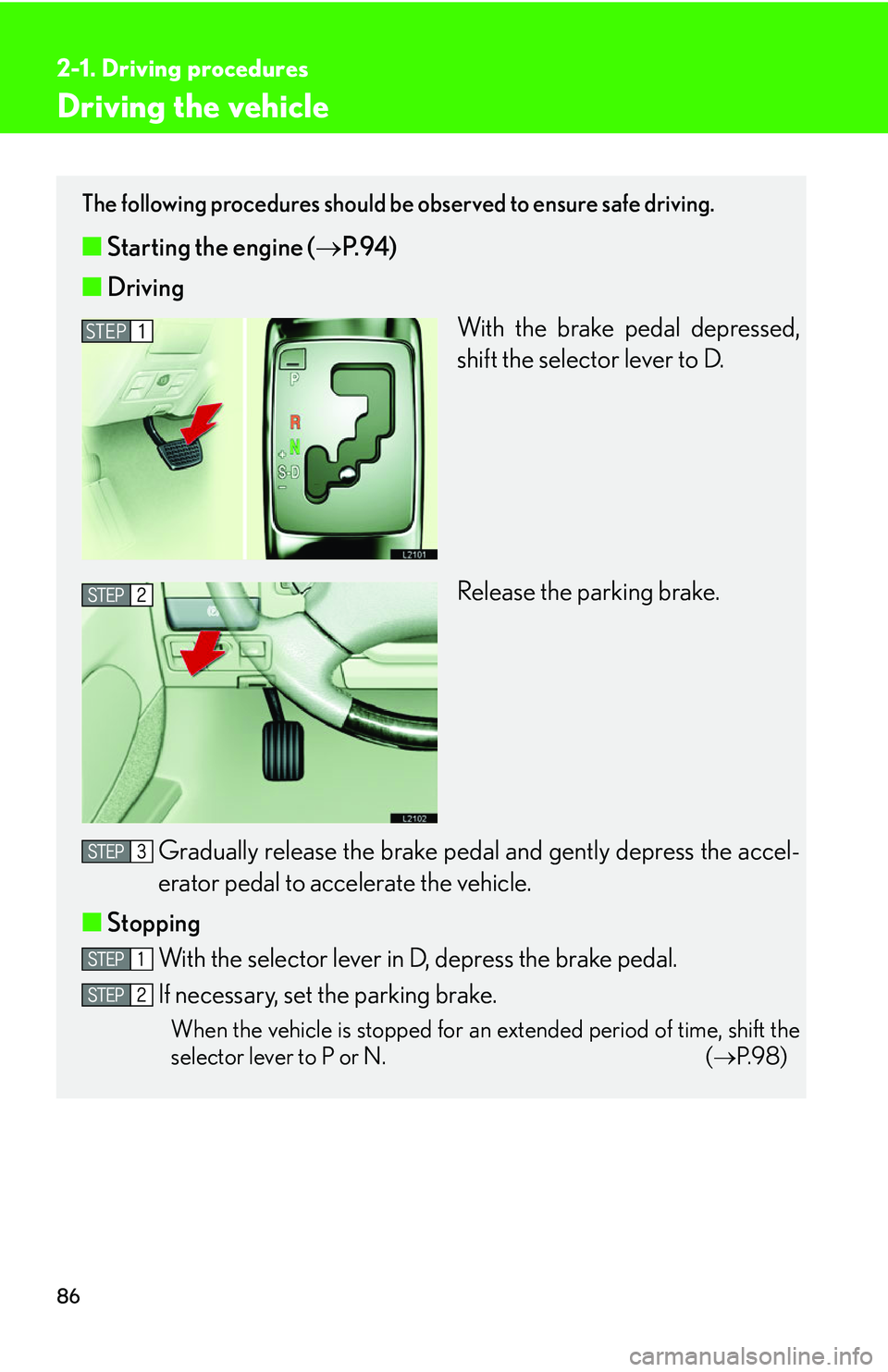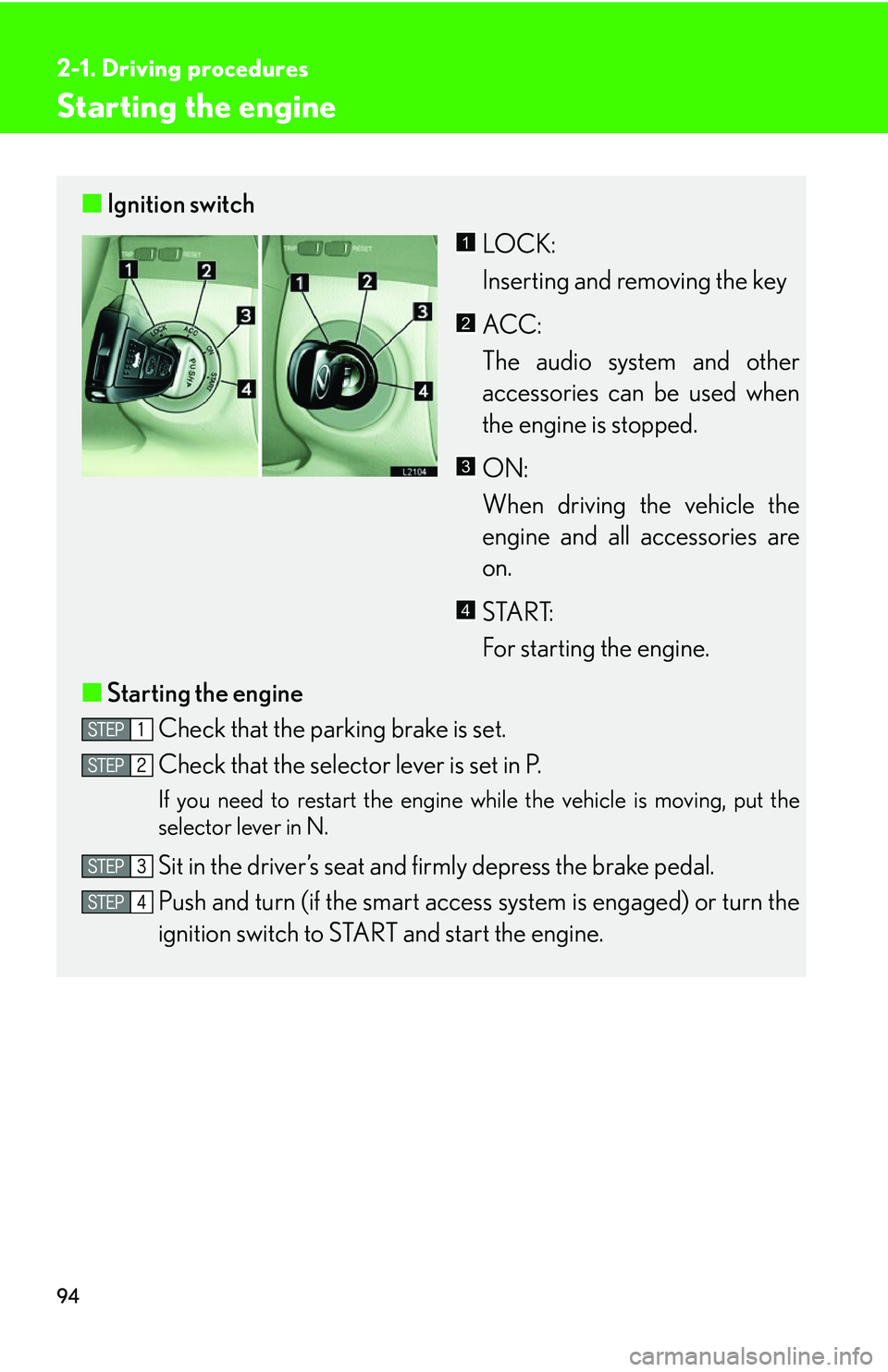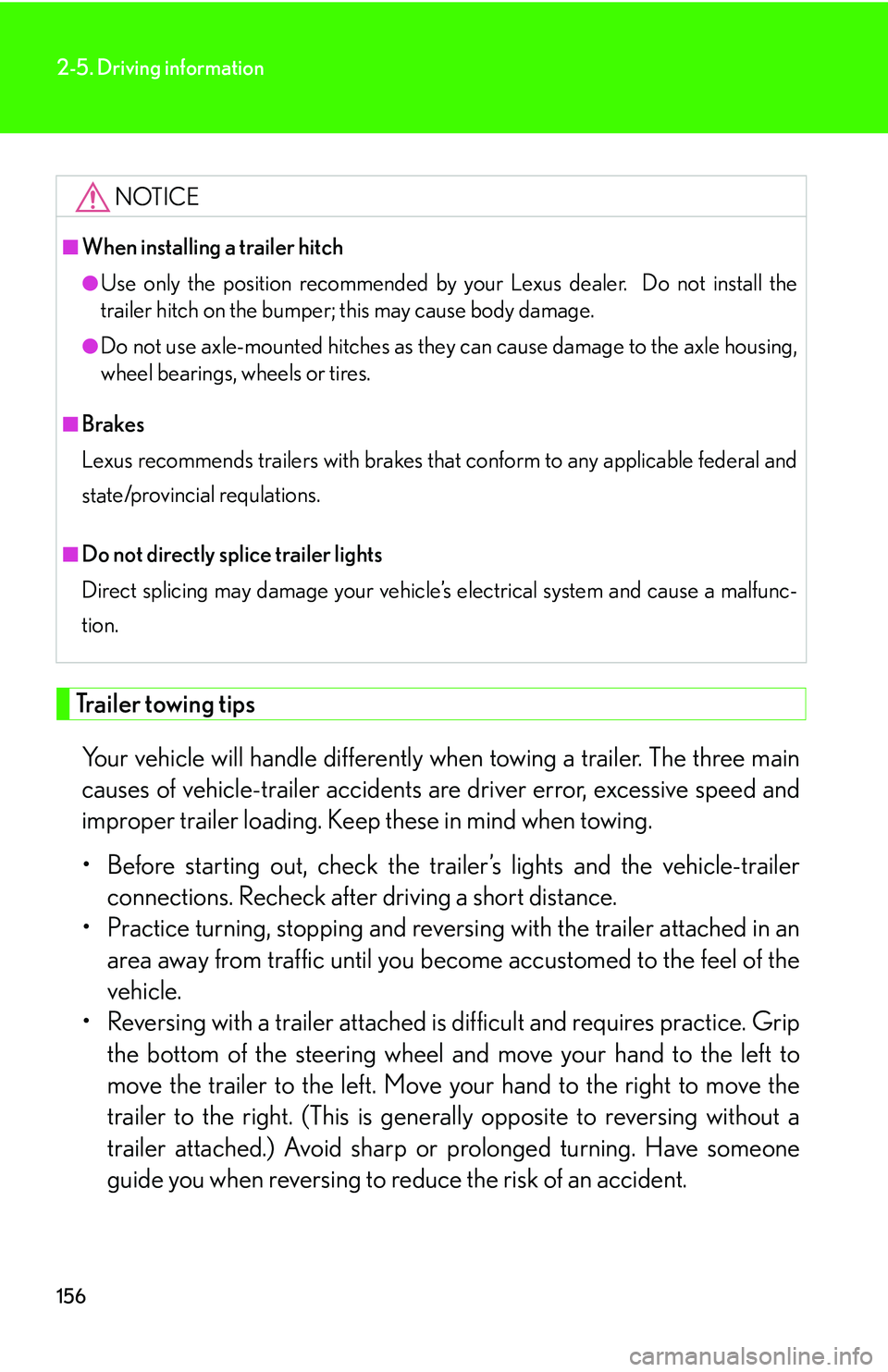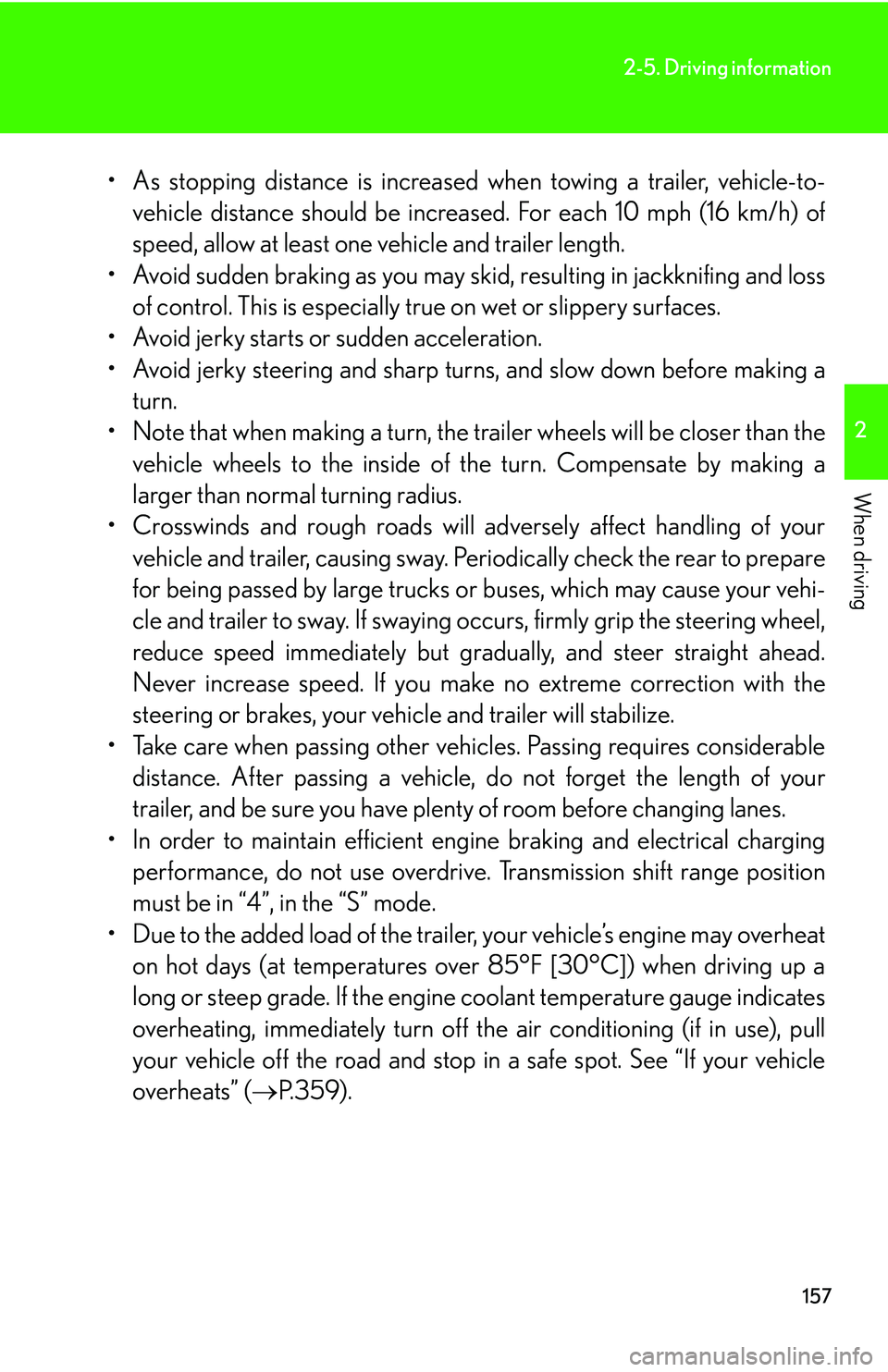stop start LEXUS LS430 2006 Owners Manual
[x] Cancel search | Manufacturer: LEXUS, Model Year: 2006, Model line: LS430, Model: LEXUS LS430 2006Pages: 419, PDF Size: 11.19 MB
Page 102 of 419

86
2-1. Driving procedures
Driving the vehicle
The following procedures should be observed to ensure safe driving.
■Starting the engine ( P.94 )
■ Driving
With the brake pedal depressed,
shif
t the selector lever to D.
Release the parking brake.
Gradually release the brake peda l and gently depr
ess the accel-
erator pedal to accelerate the vehicle.
■ Stopping
With the selector lever in D, depress the brake pedal.
If necessary, set the parking brake.
When the vehicle is stopped for an extended period of time, shift the
selector lever to P or N. (
P. 9 8 )
STEP1
Page 103 of 419

87
2-1. Driving procedures
2
When driving
Starting on a steep incline
Firmly set the parking brake and
shift the selector lever to D.
Gently depress the accelerator pedal.
Release the parking brake.
■ Parking the vehicle
With the selector lever in D, depress the brake pedal.
Set the parking brake. (
P.102 )
Shift the selector lever to P. (
P.98 )
Stop the engine.
Page 104 of 419

88
2-1. Driving procedures
■ Braking in your new Lexus
To extend the life of the vehicle, observe the following precautions.
For the first 200 miles (300 km):
Avoid sudden stops.
For the first 1000 miles (1600 km):
• Do not drive in excess of 62 mph (100 km/h).
• Maintain engine speed of between 2000 and 4000 rpm.
• Avoid sudden acceleration.
• Do not drive at a constant speed for e
xtended periods.
■Operation in foreign countries
Comply with the relevant vehicle registration laws and confirm the availability
of the correct fuel (unleaded and minimum octane rating P.373
).
CAUTION
■When starting the vehicle
Always keep your foot on the brake pedal while stopped with the engine running.
This pr
events the vehicle from creeping.
Page 110 of 419

94
2-1. Driving procedures
Starting the engine
■Ignition switch
LOCK:
Inserting and removing the key
ACC:
The audio system and other
acces
sories can be used when
the engine is stopped.
ON:
When driving the vehicle the
engine an
d all accessories are
on.
START:
For starting the engine.
■ Star
ting the engine
Check that the parking brake is set.
Check that the selector lever is set in P.
If you need to restart the engine while the vehicle is moving, put the
selector lever in N.
Sit in the driver’s seat and firmly depress the brake pedal.
Push and turn (if the smart access s
ystem is engaged) or turn the
ignition switch to STAR T and star
t the engine.
1
2
3
4
Page 127 of 419

111
2-3. Operating the headlight and windshield wipers
2
When driving
Daytime running light system
The headlights turn on automatically (at a reduced intensity) whenever the
engine is started and the parking brake is released to make your vehicle
more visible to other drivers. Dayt ime running lights are not designed for
use at night.
■Headlight control sensor
■Automatic light off system
The headlights turn off automatically if the engine is stopped and the driver’s door is
opened wh
ile the headlights are turned on.
To turn the headlights on again, turn the key to ON, or turn the light switch off once
and then
back to or position.
■Automatic headlight leveling system
The level of the headlights is
automatically adjusted according to the number of
passengers and the loading condition of the vehicle to ensure that the headlights do
not interfere other road users.
■Customization
The time it takes for the headlights to automatically turn on or off can be changed.
( P.384 )
The sensor may not function properly if an
object is placed on the sensor, or anything
that blocks the sensor is affixed to the wind-
shield.
Doing so interferes with the sensor detect-
ing the level of ambient light and may cause
the automatic headlight system malfunc-
tion.
Page 128 of 419

112
2-3. Operating the headlight and windshield wipers
Adaptive front lighting system (AFS)
To improve road illumination when turning, the right side headlight moves right
on right turns, and the left side headlight moves left on left turns.
Adaptive front lighting system
cancel switch
On
Off
When the system is canceled,
the “
AFS OFF” indicator lights
up in the instrument cluster.
1
2
3
■Operating conditions
The system starts to operate when the v
ehicle’s speed increases above 6 mph (10
km/h), and stops when the vehicles speed drops below 6 mph (10 km/h).
■When the “AFS OFF” indicator light flashes,
This indicates a system failure. Have your vehicle checked at your Lexus dealer.
NOTICE
■To prevent battery discharge
Do not leave the lights on longer than necessary when the engine is not running.
Page 156 of 419

140
2-4. Using other driving systems
Driver assist systems
When VSC or TRAC is operating
If the vehicle is in danger of slip-
ping or the rear wheels spin, the
slip indicator ligh t flash to indicate
that the s
ystems have been
engaged.
A buzzer (intermittent) sounds
when VSC is operating.
To help enhance improve vehicle safety, the following systems operate auto-
matically in certain driving conditions.
■ ABS (Anti-lock Braking System)
Help ensure steering performance in th e event of sudden braking or driving
on slippery road surfaces.
■ BA (Brake Assist)
Generates an increased level of braking force after the brake pedal is
pushed, when the system detects a panic stop situation.
■VSC (Vehicle Stability Control)
Helps the driver to control skidding wh en swerving suddenly or turning on
slippery road surfaces.
■ TRAC (Traction Control)
Helps maintain drive power and prevents spinning the rear wheels when
starting the vehicle or accelerating on slippery roads.
■Pre-collision system (if equipped)
( P. 1 4 3 )
Page 157 of 419

141
2-4. Using other driving systems
2
When driving
To disable VSC and TRAC
If the vehicle gets stuck in fresh snow or mud, VSC and TRAC may
reduce power from the engine to the wheels. You may need to turn VSC
and TRAC off to enable you to rock the vehicle in order to free the vehi-
cle.
Push the button to turn off VSC
and TRAC.
The TRAC OFF indicator light
turns on.
Push the button again to turn the
sy
stem back on.
1
■Operating sounds and vibrations caus ed by the ABS, VSC & TRAC systems
●A sound may be heard from the engine compartment when the engine is
started or just after the vehicle begins to move. This sound does not indicate that
a malfunction has occurred in any of these systems.
●Any of the following conditions may occur when the ABS, VSC and TRAC sys -
tems are operating. None of these indicates that a malfunction has occurred.
• A sound may be heard.
• Vibrations may be felt through the vehicle body and steering.
• A motor sound may be heard after the vehicle comes to a stop.
• The brake pedal may pulsate slightly while the ABS is activated.
• The brake pedal may move forward slightly after the ABS is activated.
■Failure warning for VSC or TRAC system
If an error in the VSC or TRAC systems is
detected, the master warning light and
TRAC OFF indicator light comes on, a warning tone sounds. (P.334 )
Page 172 of 419

156
2-5. Driving information
Trailer towing tips
Your vehicle will handle differently when towing a trailer. The three main
causes of vehicle-trailer accidents are driver error, excessive speed and
improper trailer loading. Keep these in mind when towing.
• Before starting out, check the tra iler
’s lights and the vehicle-trailer
connections. Recheck after driving a short distance.
• Practice turning, stopping and reversi ng with the tr
ailer attached in an
area away from traffic until you be come accustomed to the feel of the
vehicle.
• Reversing with a trailer attached is dif
ficult and requires practice. Grip
the bottom of the steering wheel and move your hand to the left to
move the trailer to the left. Move yo ur hand to the right to move the
trailer to the right. (This is gene rally opposite to reversing without a
trailer attached.) Avoid sharp or prolonged turning. Have someone
guide you when reversing to redu ce the risk of an accident.
NOTICE
■When installing a trailer hitch
●Use only the position recommended by your Lexus dealer. Do not install the
trailer hitch on the bumper; this may cause body damage.
●Do not use axle-mounted hitches as they can cause damage to the axle housing,
wheel bearings, wheels or tires.
■Brakes
Lexus recommends trailers with brakes that conform to any applicable federal and
sta
te/provincial requlations.
■Do not directly splice trailer lights
Direct splicing may damage your vehicle’s electrical system and cause a malfunc -
tion.
Page 173 of 419

157
2-5. Driving information
2
When driving
• As stopping distance is increased when towing a trailer, vehicle-to-
vehicle distance should be increas ed. For each 10 mph (16 km/h) of
speed, allow at least one vehicle and trailer length.
• Avoid sudden braking as you may sk id, r
esulting in jackknifing and loss
of control. This is especially true on wet or slippery surfaces.
• Avoid jerky starts or sudden acceleration.
• Avoid jerky steering and sharp turn s, and slo
w down before making a
turn.
• Note that when making a turn, the tr ailer wheels will be closer than the
v
ehicle wheels to the inside of th e turn. Compensate by making a
larger than normal turning radius.
• Crosswinds and rough roads will ad v
ersely affect handling of your
vehicle and trailer, causing sway. Peri odically check the rear to prepare
for being passed by large trucks or buses, which may cause your vehi-
cle and trailer to sway. If s
waying occurs, firmly grip the steering wheel,
reduce speed immediately but gradually, and steer straight ahead.
Never increase speed. If you make no extreme correction with the
steering or brakes, your vehi cle and trailer will stabilize.
• Take care when passing other vehicl es. P
assing requires considerable
distance. After passing a vehicle, do not forget the length of your
trailer, and be sure you have plenty of room before changing lanes.
• In order to maintain efficient engine br
aking and electrical charging
performance, do not use overdrive. Transmission shift range position
must be in “4”, in the “S” mode.
• Due to the added load of the traile r
, your vehicle’s engine may overheat
on hot days (at temperatures over 85°F [30°C]) when driving up a
long or steep grade. If the engine coolant temperature gauge indicates
overheating, immediately turn off the air conditioning (if in use), pull
your vehicle off the road and stop in a safe spot. See “If your vehicle
overheats” ( P.359 ).